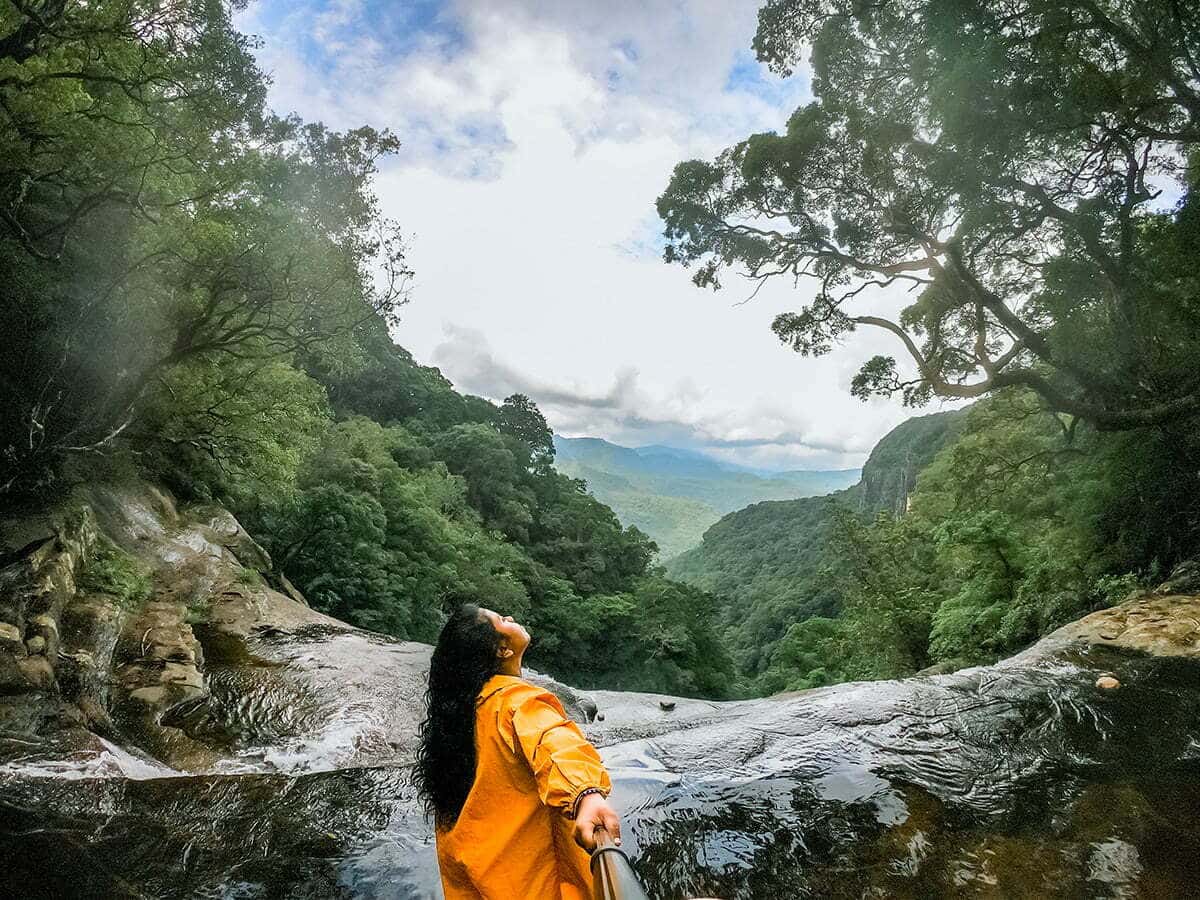Knuckles range also called ‘Dumbara’ mountain range lies in the central highlands of Sri Lanka, in the districts of Matale and Kandy.
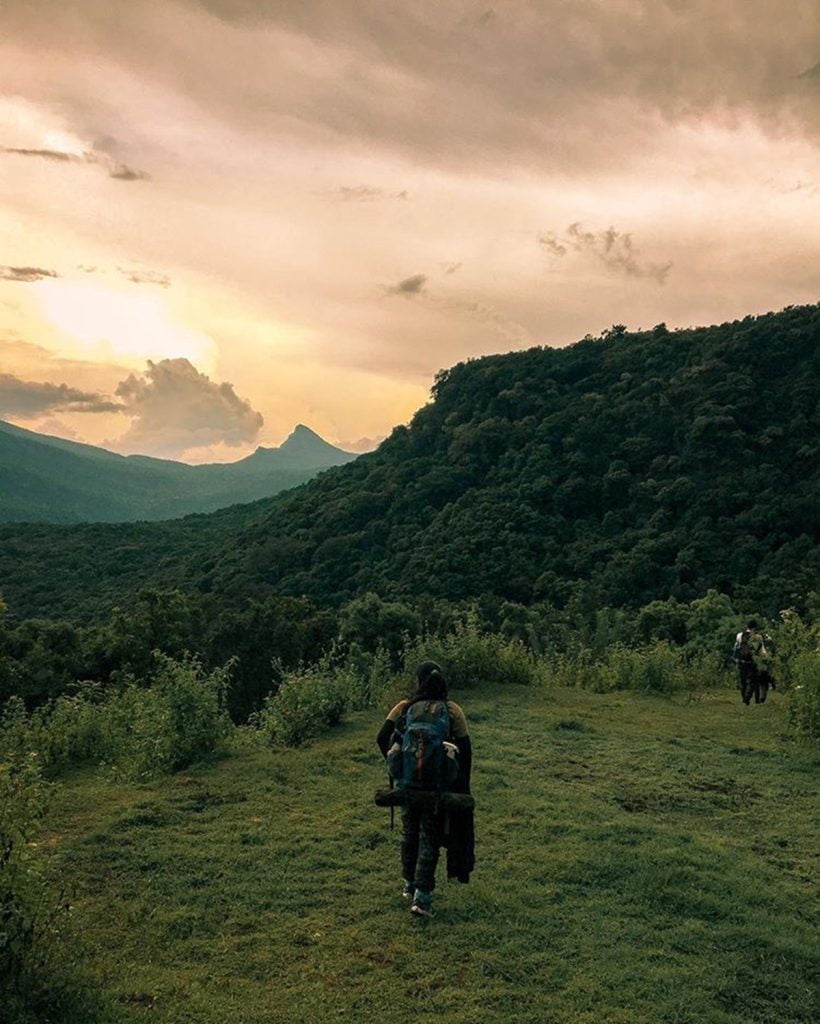
To the northern end of the highlands is where the knuckles mountain range exactly lies, and to the south and east of the mountain range is the Mahaweli river basin while to the west is Riverton and the Matale plains. This mountain range takes its name due to its view of the mountain range of five peaks in the west most massifs that resembles the sight of a knuckle over a clenched fist when viewed at certain locations in the central province.
Thus it gains its English name “Knuckles” as per the British surveyors named it whilst the Sinhala name “Dumbara” goes with the meaning ‘mist-laden mountain range.
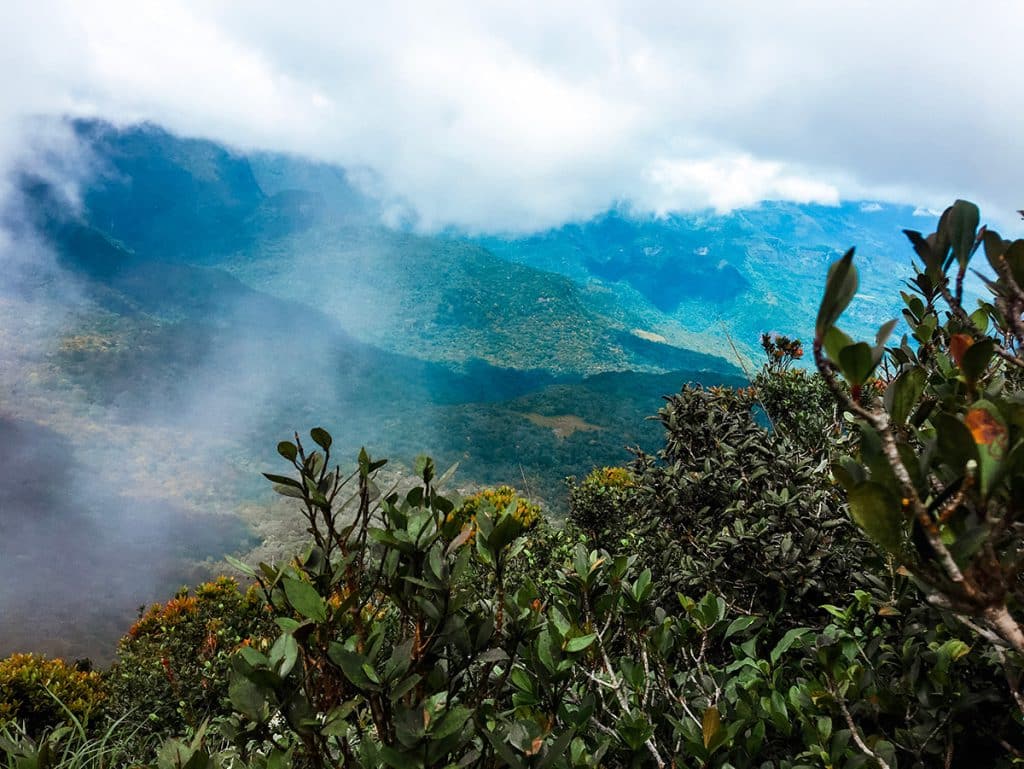
Enriched flora and fauna adds a better aesthetic value to the thick forest reserve while the range is of a great scientific interest too. The thick layers of cloud in the higher elevations experiment climatic variations throughout the year.
Knuckles conservation forest reserve covers approximately 0.03% of the island’s land area signifying the country’s rich biodiversity in nature. More than 34% of Sri Lanka’s endemic plantations such as trees, shrubs and other medicinal plants are found in the thick forests inside of Knuckles harboring its valuable ecology.
Due to its utmost naturalistic diversity, Knuckles Conservation Forest was included in UNESCO natural world heritage list from 2010 onwards and trekking inside of knuckles initially requires permission from the National Wild Life Department.
Weather and Climate at Knuckles Range
The Knuckles mountain range has unpredictable weather conditions that transform within few minutes.
Breeze of rains could occur at any time of the day where thick layers of mist could shroud at any minute in any part of the forest reserve.
The average rainfall at Knuckles ranges from 3000-5000ml and the temperature ranges from 5 ̊C to 35 ̊C. The Southwest monsoon brings rain through a gap in the range of mountains.
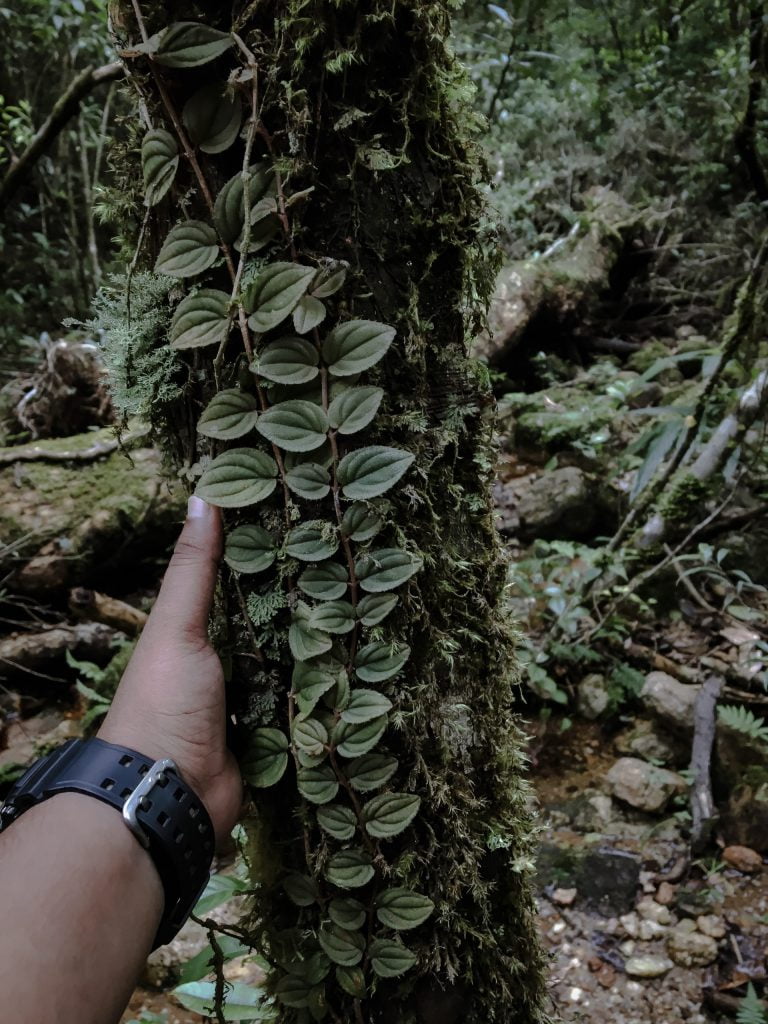
Due to the variation of rainfall throughout the year, the travelers could enjoy their trekking as follows. From December to February, the rainfall is moderate, and from March to May; the rainfall being low, and from June to September; there is a lowest possibility of rain and most of the waterfalls get dried up meanwhile.
During September to November, the rainfall becomes higher, and the leeches’ paradise least attracts trekkers during this season. Most of the trekkers love to pay a visit at the forest reserve during December to May as the flourished ecosystem nests the climatic experiences at central highlands while the waterfalls are in their full flows at the time.
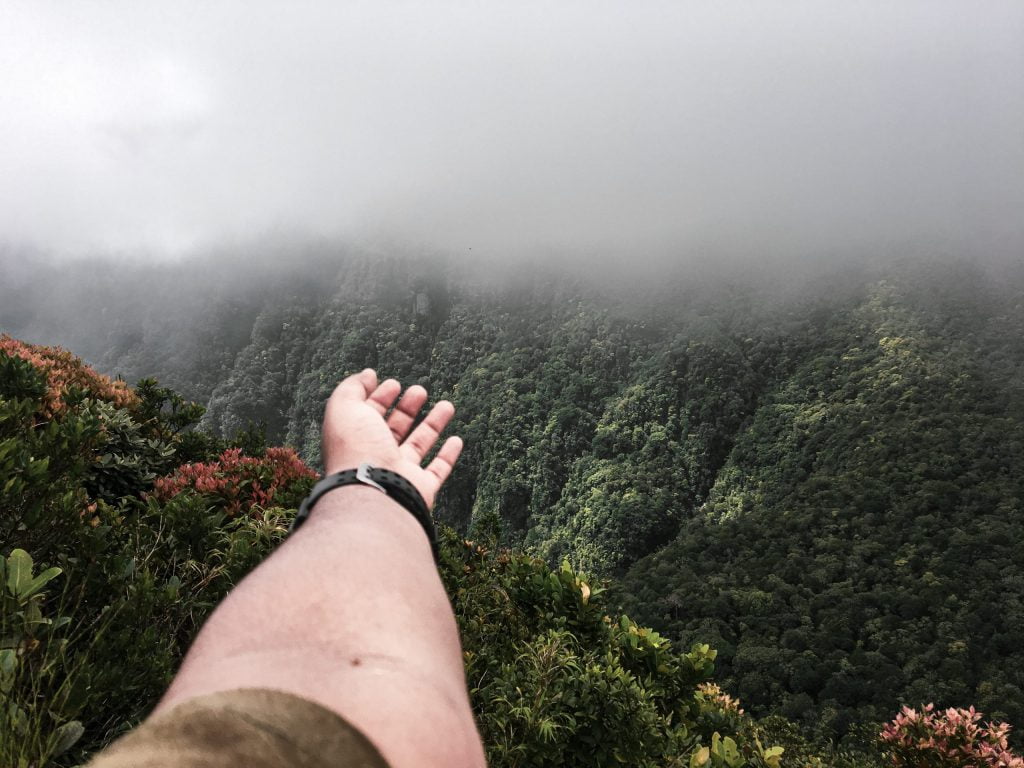
The average wind speed is around 7.2km per hour (7.2 kmph) and the humidity in the range lies between 57-90%. Also there are around 77 villages around the knuckles range which are inhibited by traditional villagers who depend upon Rice, Chena and Cardamom cultivation’s.
Kalupahana in the Knuckles range is very popular for Cardamom productions where there are acres of Cardamom plantations that set productions for exportation’s as well. This is because the climatic conditions really suit for these plantations and cultivation’s, but this has become a common threat to the natural ecosystem of the area.
Ecosystem and Biodiversity at Knuckles Range
Diversity of species and the great diversity in the forest cover support the well-established ecosystem in the range. Biodiversity is thus a hotspot of nature at Knuckles range that assures home to many endangered and endemic animal species and plants. Knuckles range is the home for many mammals such as spotted deer, barking deer, mouse deer, wild boars, elephants, samburs, giant squirrels, purple faced leaf monkeys, mongoose, porcupines, leopards, wild oxen, and many others.
There are several endemic lizard species found at the forest reserve and some of them are Crestless Lizard (Calotes Leocephalus), Kangaroo Lizard (Otocryptus Wiegmanni), Leaf Nose Lizard (Ceretophora Tennennti) which is only found at the Knuckles range, Pigmy Lizard (Cophotis ceylonica) and other. In addition, the Knuckles Conservation Forest is deemed a UNESCO World Heritage partly as 64% of the amphibians and 51%of the reptiles here are endemic to Sri Lanka.
Diversity of bird species is another attractive feature that many eco-travelers get attracted to trek through the knuckles range. This area is home for more than 200 bird species and around 15 of them are endemic to Sri Lanka: Spot Wing Thrush, Sri Lankan Blue Magpie Jungle Fowl, Yellow-fronted barbet, small barbet, Sri Lankan Warbler, White faced starling, Sri Lanka white-eye, Black-headed Bulbul, Yellow-eared Bulbul, Dusk Blue Flycatcher, Brown Capped Babbler and Layard’s parakeets are among them.
The forest cover is of a great diversification with dry and evergreen forests, humid semi-evergreen forests, montane vegetation forests, tropical sub-montane forests, sub-montane evergreen rain forests, dry and wet pathanas, savannas, plains etc.
Along the river banks verdant riverine flourish while savannas expand along hill slopes. The specialty about the Knuckles range is that 20% of the plants herein are found to be endemic to Sri Lanka.
A wide range of hardwood such as ‘Kaluwara’ and “Maho’, and herbal plants with an immense value are found evidently inside the forest reserve.
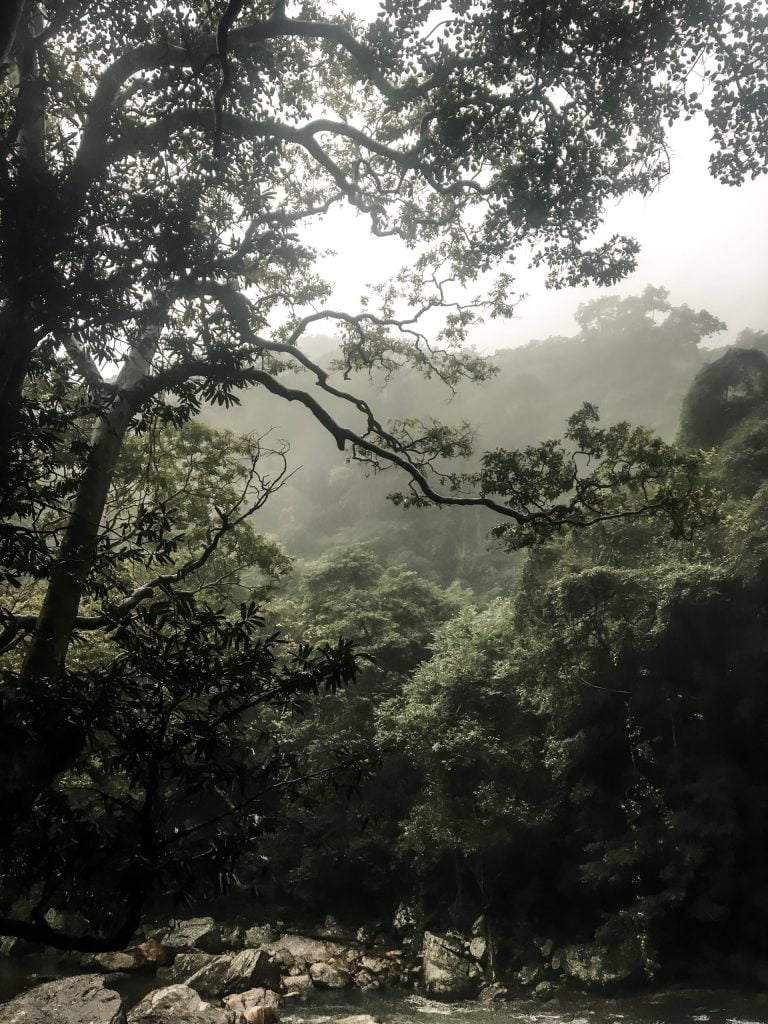
While there are around 160 endemic flowering plants, the Knuckles Forest Range is also the home to one-third of the country’s flowering species which includes 25 types of orchids. The upper cloud forests are vibrant with colorful orchids, ferns and mosses. Also the thick canopy of short and climate appropriate trees facilitates the rich and humid soil to grow more plants with natural fertilizing.
The most unique aspect of Knuckles range that supports its ecosystem and the great biodiversity is its microcosms of various climatic conditions found island wide. Ranging from extremely wet to near arid, the forest reserve presents climatic variations that suits for the growth of its plants and survival of other species.
A Trek through Knuckles Range
Knuckles mountain range features 34 peaks ranging in height between 900m to 1900m. The highest peak, “Gombaniya” is 1906m (6248ft) in height. The Knuckles mountain range is one such loveliest nature attraction to the local and international travelers affording immense trekking possibilities at the untouched zone of natural beauty.
The significance of biodiversity interspersed with cascading waterfalls, changing terrain of grasslands, thick canopies of forest grounds, rugged mountain peaks and heavenly cloud forests add an extra diversification to the Knuckles range.
The mountain range conquers an area of 18,512 hectares of land area making it a wild paradise for trekkers. Travel enthusiasts who are keenly interested in hard treks and eco traveling tend to love a hike over 40 plus kilometers inside the mountain range taking 2 to 3 or more days while camping at nights inside the forests.
There are a number of routes that paves entry to the Knuckles Conservation forest and the two most famous routes are from Matale via Rattota, and from Waththegama via Panvila. These two routes are the most famous entries among local trekkers and are equally hard to trek.
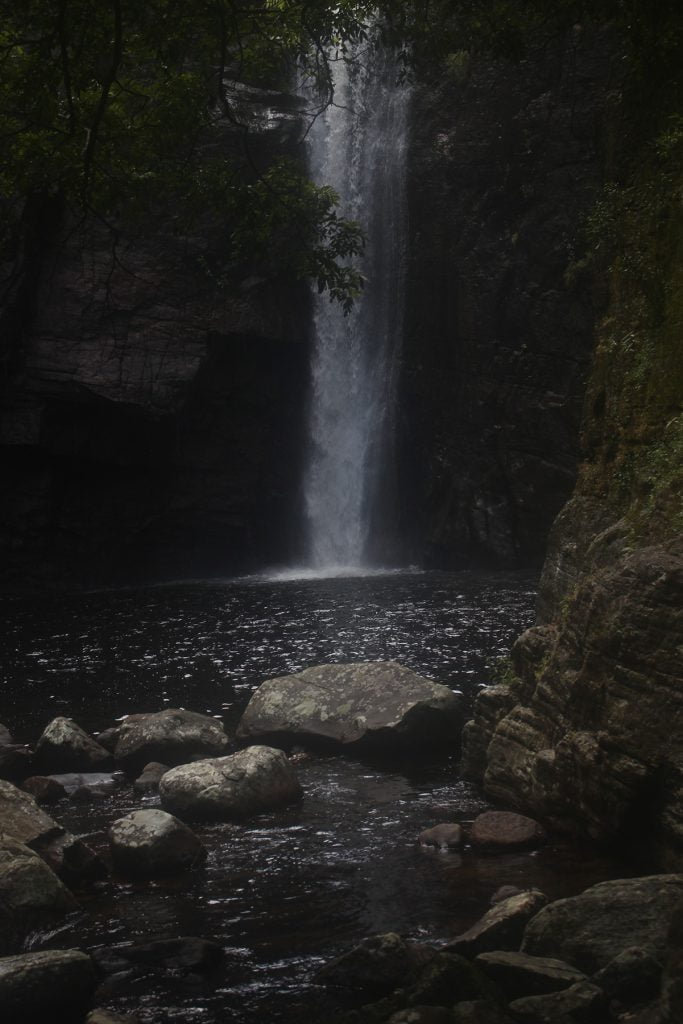
I have conquered the mountains through both these ways and it was really a great experience I have gained in my life. In 2019 April, I stepped to the Knuckles mountain range initially and it was from the entry point at village “Atanwala”. The trek was around 42km and I did pass the island’s smallest village which is called “Walpolamulla” that was currently being isolated except for some farmers who came to check on their cultivation’s. The natural geographical variations were profound throughout the hike and it made us cross over streams, climb over dangerous slopes and meet with the leech attacks very often.
On the first night, we camped around “Dumbara” falls. Dumbara falls or “Dumbara ella” in Sinhala is called to be the heart of the Knuckles mountain range. This waterfall is in her full flows during the rainy season, but never dries up during the other times of the year. The waterfall gets the Sinhala name of the mountain range, which is “Dumbara”, as it is one of the most important destinations inside the mountain range. There was a little nervousness when camping at nights, because it was said that there were leopards coming at nights to the caves near the fall.
Also due to the unexpected flow of water, it is not safe to camp at the rocks standing in the middle of the water flow. Thus we camped at a huge rock beneath the stream; coming down from the waterfall. We had to face a continuous shower of rain throughout the night, but the following day was a sunny day that made us dried up our accessories to get ready for another day of adventure. In the morning hours, we were able to see hundreds of butterflies in different colors and we felt that area was a kind of paradise for butterflies.
The second day of the trail was planned for reaching “Duwili” falls via Infinity Pool. Infinity pool is one such photogenic destination that showcases a beautiful view of the mountains around. The end of this water stream seems to be infinite and thus it gains its name.
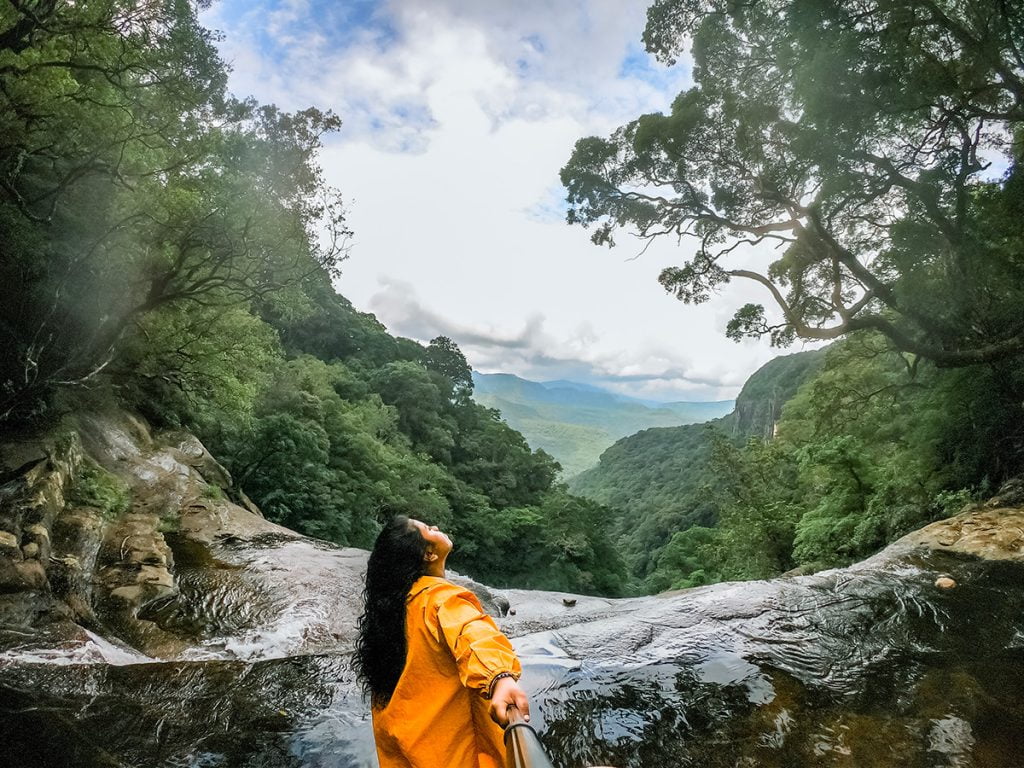
Duwili ella, where “Duwili” is ‘Dust’ in English, gets its name due to its fall of water significantly as dust particles from above. One other important factor with regard to this fall is the visibility of the waterfall in both the front and interior views. The interior view can be gained accessing to the right end corner of the Duwili ella cave.
The Duwili ella cave is one such famous spots among trekkers as it allows the trekkers to rest inside this cave even without setting any camping tent. This cave doesn’t get wet even during high rainfalls. The place was an eternal heaven for me as a nature enthusiast. This was my first trek at the Knuckles range and I started falling for Knuckles more and more thereafter.
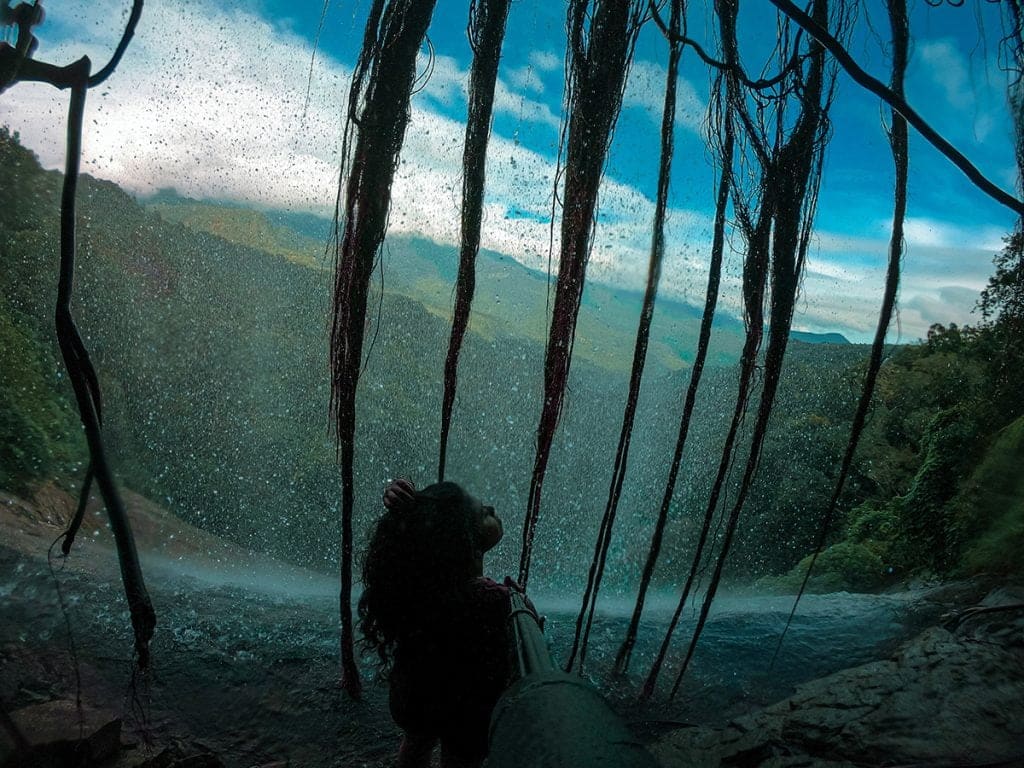
My second visit to Knuckles range was during last November 2019. It was through the entry point at Bambarella village in Waththegama. Starting the journey from the Lebanon estate at Bambarella, we reached the famous “Rathnagiriya” mountain that let us gain the last panoramic view of the knuckles mountains before we enter in to the forest reserve. It took us around 6 1/2hours to reach the ‘KMP wādiya’ at Kalupahana to rest for the day. KMP is a resting place used by the cardamom cultivators from the villages such as “Ranamure”. These villagers also have got used to help out the trekkers who come to their places and they are very kind people rich in hospitality. “Mahathun mama”; a villager who’s mostly in his late 50’s is one such famous character who lives in KMP and helps out the trekkers who visit the place randomly.
We stayed our first night at KMP and on the next day morning, we conquered the mountain “Thunthisgala”. This mountain is very specific among the other mountain peaks in the range, because it allows us to see all other 33 peaks in one panoramic frame, if the day has a good climate. And thus it gains its name: reflecting “Thun-this” for other 33 mountains belonging to the Knuckles range. As the mountain is 1,628m (5,341ft) in height, the area is sunken in thick cloud layers most of the time. This mountain is also called in the name “Thunhisgala”, because it has three heads or three visible peaks on it.
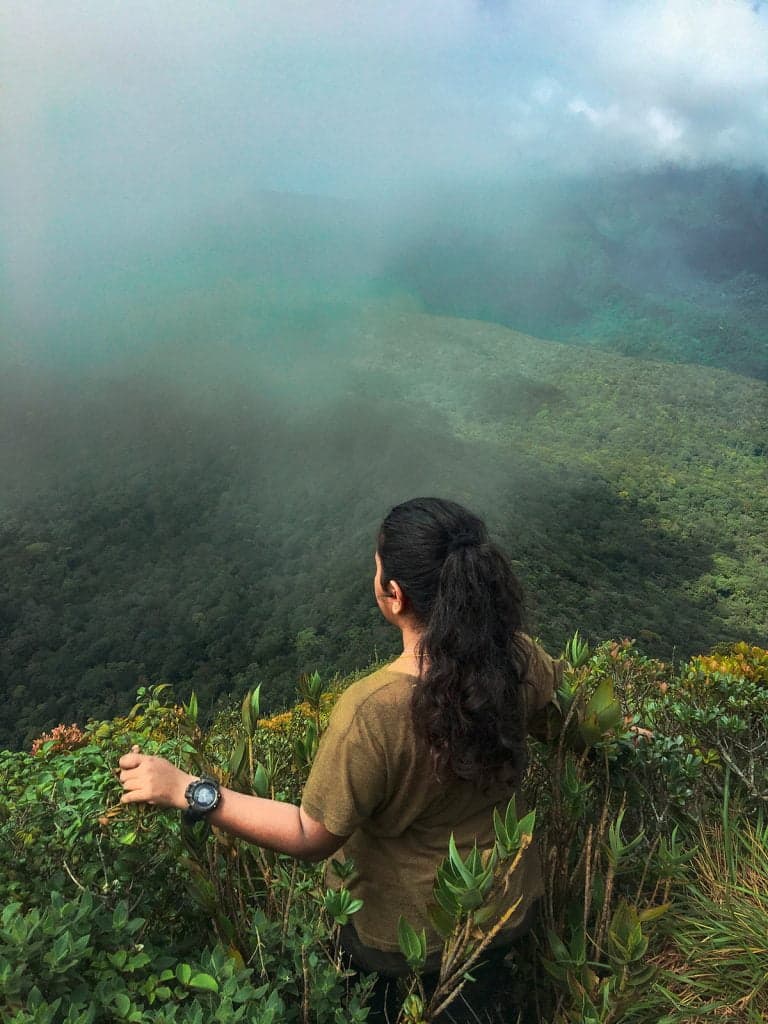
After conquering this mountain, we came back to the KMP. After having the lunch we prepared, we started our next trail to Duwili ella. It was my second time to Duwili ellaand the trek was through a different route. We took around 4 ½ to 5 hours and reached Duwili ella cave to rest for the night. It was my first night at Duwili ella cave, since at the last time we camped at the foot of the waterfall as there were another set of trekkers who already had settled inside the cave. Thus, another day spent in the heaven with all the nature’s soothing.
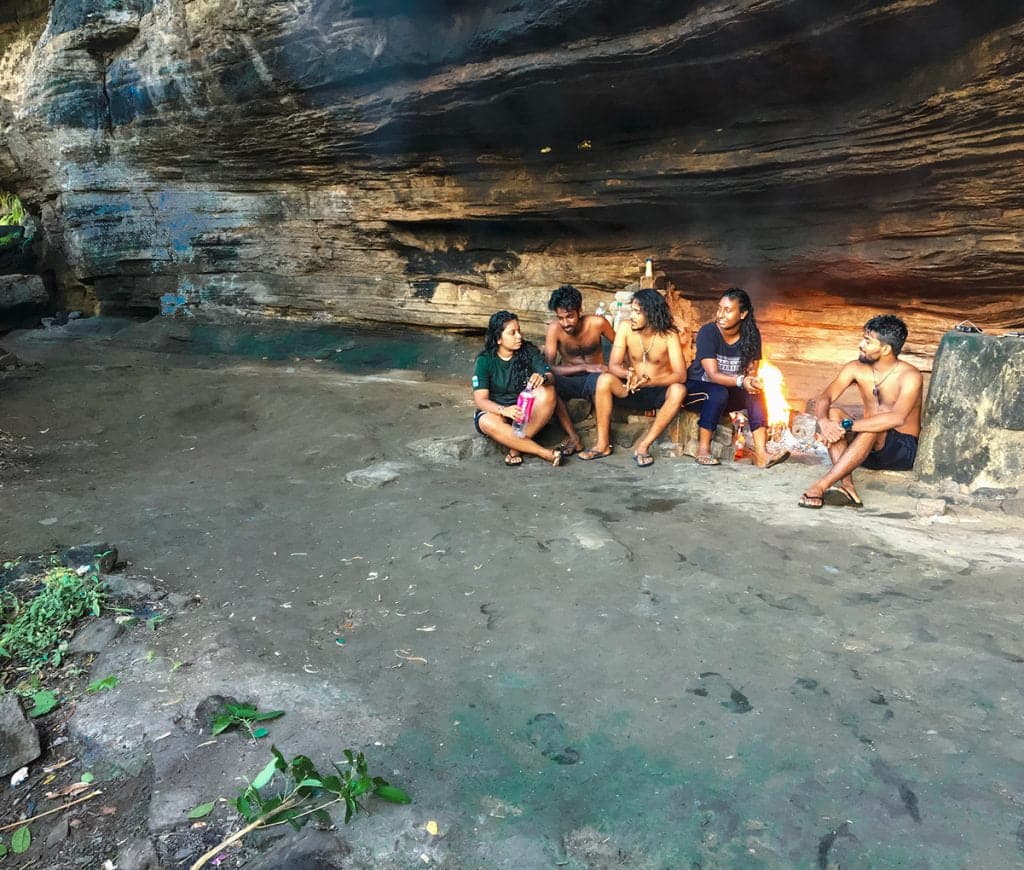
On the third day of our trail, we started descending to our destination end which is the village “Ranamure”. During the trek, we could reach the “Infinity Pool” and closer to that we could visit the “Sansun ella”. ‘Sansun ella’ has got its name because of its ‘quietness’ in the flow. The Sinhala term ‘sansun’ refers to the ‘calm and quiet’ in English.
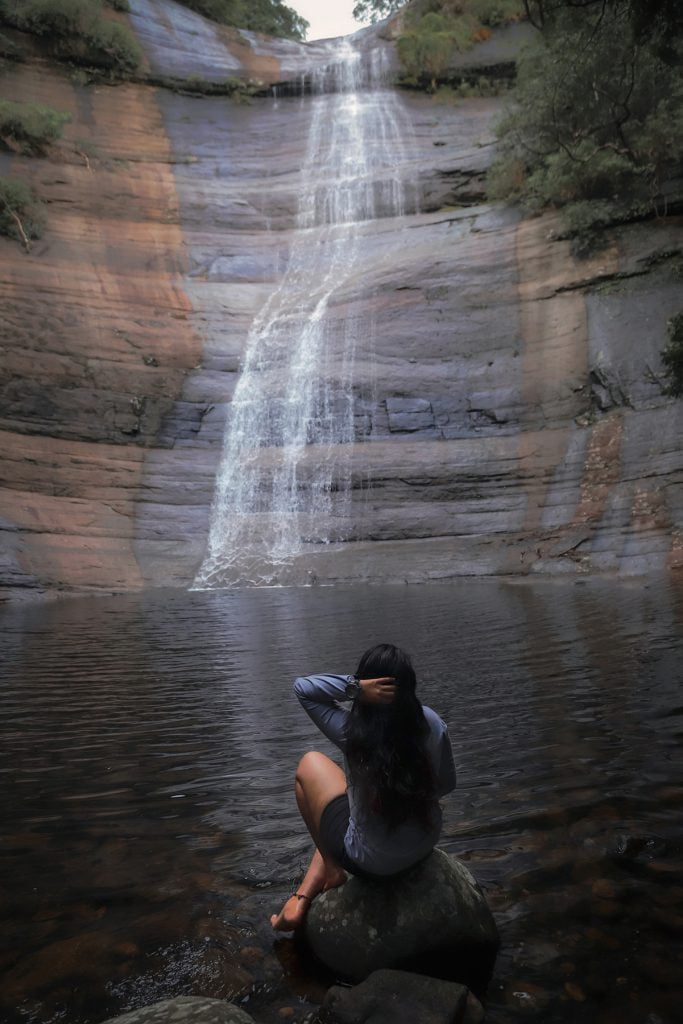
There are plenty of other waterfalls streamed from the water ways running down everywhere. Many of them are difficult to reach, especially during the rainy season.
We trekked through thick forests, grasslands, pathanas, and many other geographical variations. It was more than a 50km trek that we continued for three days inside the Knuckles mountain range.
Apart from the two routes I have taken to enter the Knuckles range, the trekkers are also fond of using popular hiking trails such as trail to “Alugallena” via Thangappuwa from Corbett’s Gap, trail to “Meemure” village from Kalupahana, trail to Mini World’s end from Deanston, trail to Dothalugala from Deanston, trail to Nitro Caves from Corbett’s Gap, or may be using the motor way running East of Kandy to Hunnasgiriya.
The B road from Hunnasgiriya leads to the Corbett’s Gap that opens the panoramic views of the Knuckles range. From Corbett’s Gap, the road that leads to Meemure can be travelled by a vehicle, and the Hunnasgiriya road that leads to Kalugala at Udadumbara is another entry point to the Knuckles range. The famous “Yahangala” and “Gerandi eli” can be reached by trekking in this Kalugala area.
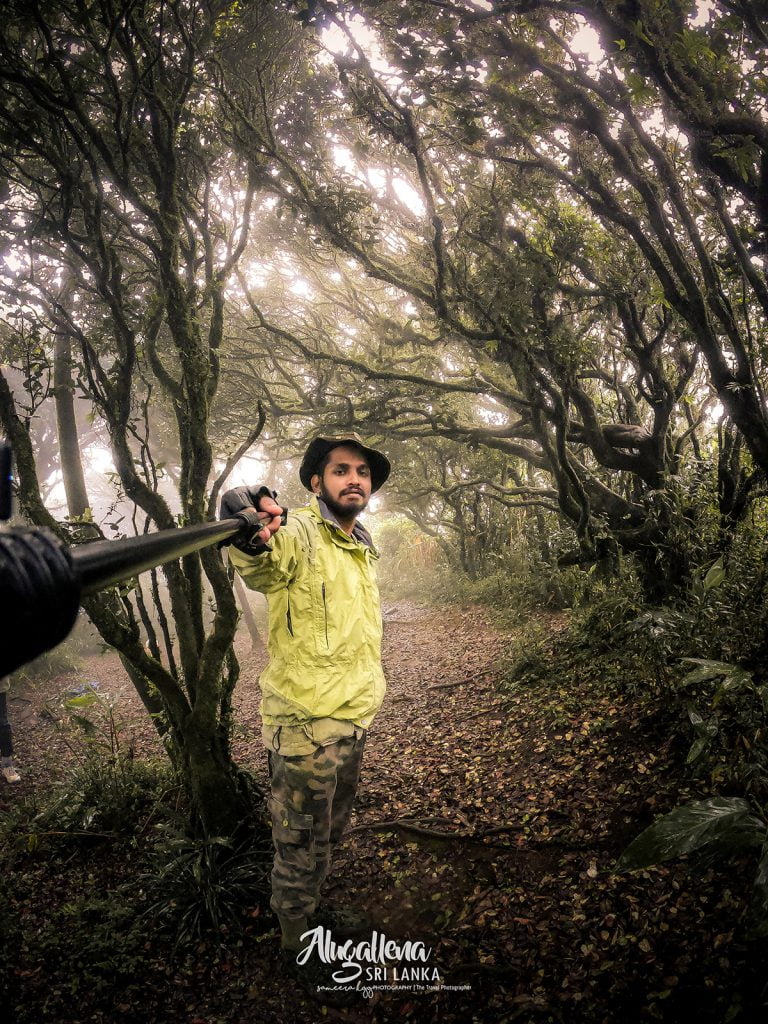
The Knuckles mountain range and the conservation forest is a fragile forest eco system that has at a large scale threat due to forest clearance for cultivation’s and also because of the invasive exotic plant species that spread into montane forests and grasslands, destroying the endemic Sri Lankan flora and fauna. We should take actions to save these rainforests to safeguard future on earth.
Travel and Leave only Foot Prints!

